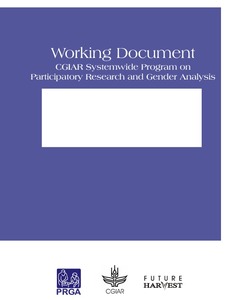Using participatory research and gender analysis in natural resource management
Abstract
The use of participatory tools and methods has increased dramatically in natural resource management (NRM) over the past decade, largely because of the recognition that sustainable NRM cannot be achieved without involving the individuals and communities who make decisions about how resources are used. Participation of resource users and other stakeholders is important not only in the management of resources, but also in research oriented toward the generation of information and innovations that shape how resources are understood and exploited. Although there is extensive literature on participatory tools and methods and a growing number of case studies of their use in NRM (Hinchcliffe et al; IDRC; Pretty), it is difficult to form a coherent overview of this body of work, much of which is unpublished. Moreover, the distinction between participatory research and participatory management is seldom made, either in case studies or in the guides to tools and methods. Yet participatory management that is not firmly linked to research�??understood as a process of knowledge generation that supports technical and institutional innovation�??is often hindered by a lack of new technical options, information and institutions. There has been little systematic analysis of how participatory research (PR) methods and gender/stakeholder analysis (GSA) are being used in NRM research. 1 This study begins to fill the gap by providing a comparative analysis of over 60 participatory NRM research projects compiled by the Systemwide Program on Participatory Research and Gender Analysis (PRGA). The paper looks at who is doing PR research and GSA in NRM, where, how and with what observed or expected impact. Projects are assessed in terms of the type of participation they use, how they select participants, and whom they target as beneficiaries. The costs and benefits associated with incorporating user participation are also analyzed

